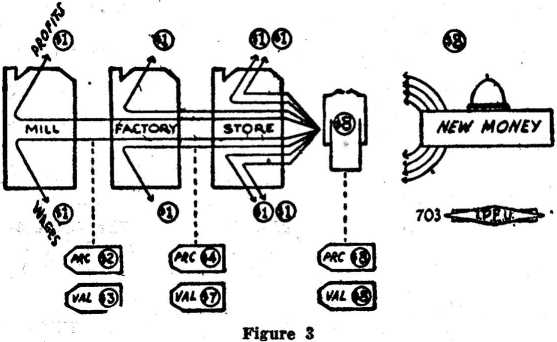
Main NI Index | Main Newspaper Index
Encyclopedia of Trotskyism | Marxists’ Internet Archive
From The Militant, Vol. X No. 35, 31 August 1946, p. 6.
Transcribed & marked up by Einde O’Callaghan for ETOL.
The share the workers get out of the total value they produce depends on how strongly they bargain against the employers. It is often said that wages are controlled by the cost of living, and while that is not strictly true it is true in a loose way – through an indirect process. The cost of living influences the bargaining power of the workers, and through that the level of wages.
When wages go too low for living, the workers must refuse to take them. At that point their organization and action become strong, in spite of all the employers can do to oppose or mislead them.
This does not mean that wages tend to stay near a proper standard of living. We might say instead that wages tend to stay near a fighting standard of living, meaning a standard below which the workers are forced to struggle. Experience shows that this standard which forces struggle is below the proper living standard. The average wage received by workers in America has always been below the figure of the U.S. Labor Department’s Budget of Health and Decency. Many studies of living levels have all shown the same thing: that wages tend to go up and down more or less in step with the cost of living, but they always remain below a decent standard of living.
Wages rise nearer to a decent standard when the workers add to their bargaining power. Through unions, and especially through independent political action, they gain more strength and raise the standard for which they can organize a struggle.
We have already sketched the process that controls the share the workers get. All the rest of what is produced in industry goes to the workers, and we call it “surplus value.” We have seen that surplus value is going up with increasing productivity. What is the effect of this?

|
To answer that we must look at the working of the law of labor value in the economic system as a whole. Through this analysis we can test out such questions as whether raising wages will raise prices, and so on.
Figure 3 is a useful diagram for the analysis which we will undertake in the next few installments of this series. It is a simplified plan of the flow of commodities and money in a capitalist system. It pictures the story of what happens to the income from one commodity, a coat, which is taken as a token for the output of all industry. Through this we can trace what happens to all income, including what happens to surplus value. The coat is sold for $8 and the eight lines going back from it show what becomes of the money.
For our present purpose we suppose that production of the coat starts in a textile mill which makes the cloth. In real life the mill would have to buy wool or cotton for raw material. But going back for other steps would not change the point for which we are using the chart, so we can keep it simple.
The mill makes the cloth and sells it to the factory for $2. The mill gets $2, which we suppose it pays out as the arrows show: $1 goes to owners for all types of profits, including rent and interest, that is, all types of income from ownership. The other dollar goes to workers for making the cloth.
The factory buys the cloth, makes it up into a coat, and sells it for $4. The cloth cost $2, so that leaves $2 for the factory. We suppose they are paid out as the arrows show: $1 to owners for profit, rent and interest; $1 to workers for making the coat.
The store gets the coat for $4 and sells it for $8. The arrows show $2 to owners for all kinds of profit; and $2 to the clerks for advertising and selling the coat.
Dotted lines from each sale point to price-tags and value-tags. The price-tags show the exchange-values, by which the capitalist economists interpret the process at each of these steps. The value-tags, giving the labor-value from productive labor, are used by Marxists to understand the process at each step in terms of production. We will see that the latter method shows us what really is happening.
Next week: Production and Income
Main Militant Index | Main Newspaper Index
Encyclopedia of Trotskyism | Marxists’ Internet Archive
Last updated on 26 June 2021